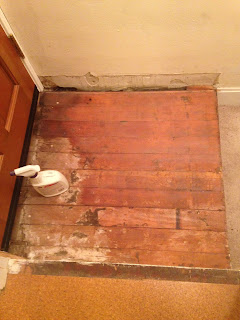As mentioned before, quickly getting a new roof on the house was a condition of our financing and we were motivated to get it done. We sought 3-4 estimates and chose the one we liked. Spring is a difficult time for roofing in Seattle because the weather is terribly unpredictable, and if you were to predict, your safest bet is rain. But, the roofer seemed optimistic, stating that they just needed a good 3 day run without rain to do the job. With spotty weather coming up, our guy said we'd be looking at the following week to start. Imagine our surprise when that Wednesday we discovered a crew on the roof tearing away shingles. They apparently finished another job early and thought they'd get started on ours. Rain was predicted for the following day. We were assured that everything would be fine--they'd tarp the roof and pick back up when it stopped raining.
 |
| Roof destruction. |
That weekend, the volume of rain in Seattle broke records. The entire month of March was the wettest in recorded history. We planned to spend the weekend at the house to prepare for our move. Just before bedtime on Friday, we jumped over a river of water at the curb and ran to the dark entry. Nick fumbled to get the key in the door. "We HAVE to get the porch light fixed," I complained. A firm shoulder to the door and we were in. Nick quickly noticed a leak in the living room and called the roofer, while I emailed the roofer from my iPad. We hoisted ourselves through the small hole in the front bedroom to access the attic. "The tarp isn't tight at the corner of the house, Nick observed."
 |
| Cellulose insulation. |
I stayed in the attic and wallowed in panic. Nick grabbed the only ladder we had--a 6 foot fold-out style and went outside. Standing on the very top of the ladder, he stretched to reach the end of the tarp to pull it back into place. It helped some, but water still splashed in. I grabbed a 5 gallon bucket and attempted to position it. With the sloping roof, the bucket was too tall to be effective at the corner. I slumped in disappointment. The attic is filled with loose cellulose insulation, so I began digging it away from the corner of the house. *BAM* An idea struck. I ran downstairs, grabbed our tarp, and returned to my spot. I pushed the insulation around to form a little crater-like indentation. I threw the tarp over it and pushed the center down into the indentation. Nick popped his head up through the attic access.
"What are you doing?" he asked.
"I'm fixing it."
"That's not going to work." he judged.
"Yes it will...I'm a genius!" I proclaimed. "You can thank me later."
 |
| Our first night. |
We went to sleep in our sleeping bags on the floor in the basement and hoped for the best.
In the morning, the rain subsided and I climbed into the attic to view my handy work. A puddle of water had pooled on the tarp and everything else was dry. I beamed at Nick.
"Now what are you going to do, genius?"
I grabbed a paper coffee cup from the trash and scooped the water off of the tarp and into my bucket one cup at a time. I had collected at least a gallon and a half, and if you ask me, saved the day.






















































